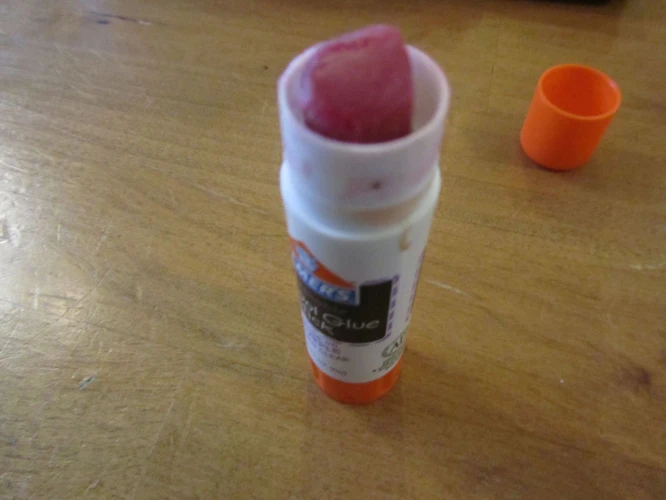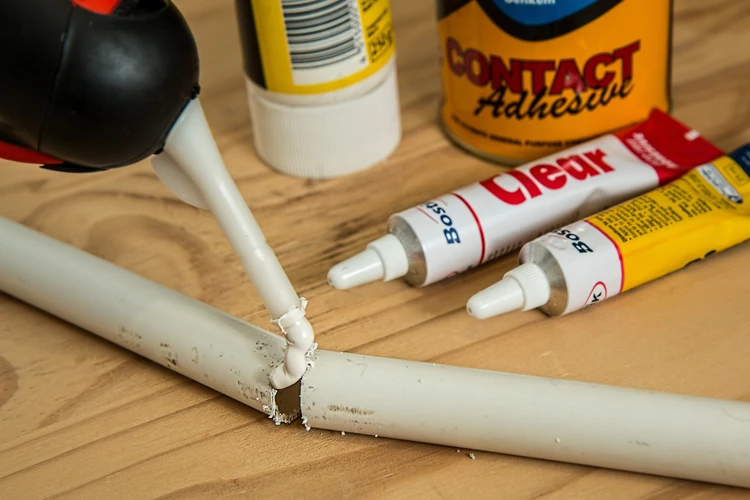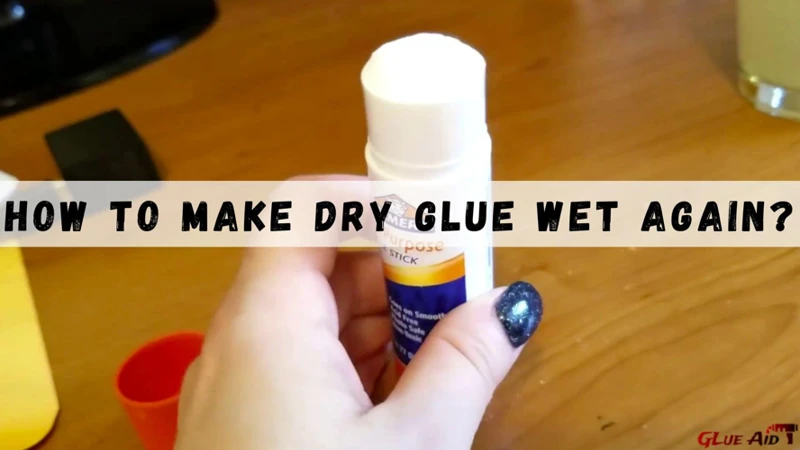Have you ever been in the middle of a project, only to discover that your glue has become dried out and unusable? It can be frustrating and time-consuming to have to run to the store for a new bottle, especially if you can fix the problem yourself. But how exactly can you make dry glue wet again? In this article, we’ll explore the various methods and techniques to rehydrate your dried-out glue. From using heat and water to solvents and vinegar, we’ll cover all the bases to get your glue back to a usable state. Plus, we’ll also discuss the dangers of using dried-out glue and how to prevent it from happening in the first place. So, let’s dive in and learn how to rescue your dried-out glue.
Why Does Glue Dry Out?
Glue is an essential tool for every DIY enthusiast. It helps to bond different materials and create a lasting connection. However, one issue that most people face is the drying out of glue over time. This can be frustrating, especially when you’re in the middle of a project and your glue is no longer usable. But why does glue dry out? Let’s explore some possible reasons.
Evaporation
When we leave glue open or don’t use it often, evaporation can occur, causing it to dry out. This is because the glue’s solvent, which keeps it in a liquid state, begins to evaporate into the air. If too much of the solvent evaporates, the glue becomes dry and useless.
To prevent evaporation, it is important to keep your glue tightly sealed when not in use. You can also store it in a cool, dry place to slow down the rate of evaporation. If your glue has already dried out due to evaporation, you can try to make it wet again using the methods mentioned in the previous section.
It is important to note that different types of glue have different rates of evaporation. For example, cyanoacrylate glue, also known as super glue, evaporates quickly due to its low viscosity. On the other hand, polyvinyl acetate (PVA) glue has a slower evaporation rate thanks to its viscosity and the presence of water in its formula.
If you’re looking for a fun and easy DIY project, you can check out our article on how to make slime without glue or freezing it. Or, if you want to learn how to properly use surgical glue for wound closure, check out our guide on how to apply surgical glue.
Absorption
Absorption is another reason why glue dries out. This happens when moisture seeps into the glue and starts to break down its adhesive properties. Glue that is left open and exposed to the air for a long time can absorb moisture from the surrounding environment. This is why it’s important to store glue in airtight containers to prevent absorption from occurring.
Aside from moisture, glue can also absorb airborne contaminants such as dust, dirt, and other particles, causing it to dry and harden. When using glue, always make sure to work in a clean and dust-free environment. You can also use a clean cloth or rag to wipe the nozzle and cap clean after each use.
To avoid glue absorption, it’s also important to choose the right type of glue for the project. For example, if you’re working with paper or cardboard, a glue stick might be a better option as it prevents absorption compared to liquid glue. Additionally, make sure you’re using the right type of glue for the material you’re bonding. Using the wrong type of glue can cause it to dry out quicker due to absorption and might not bond the materials properly.
Remember that prevention is key when it comes to glue absorption. So, make sure to follow proper storage and handling procedures, picking the right glue for the job, and working in a clean environment. By doing so, you can prevent your glue from drying out and save it from being thrown away.
Contamination and Exposure
Contamination and exposure are also factors that contribute to glue drying out. When glue is contaminated with other substances like dust, dirt, or excess air, it becomes less effective and prone to dry out faster. The exposure of glue to elements like air, moisture, and heat also affects its longevity and consistency.
To prevent contamination, always make sure to seal the glue containers tightly after use. Additionally, avoid using any tools or surfaces that are not clean when applying glue, as this can add contaminants to the glue.
Exposure to air is one of the more common causes of glue drying out, especially when the container is left open. When applying glue, use a brush that seals well and does not let air inside the container. Try to keep the container in a cool and dry place, away from direct sunlight.
Pro tip: If you often store your glue in places where it’s exposed to air, you can store it in a vacuum-sealed bag to prevent drying out.
If you want to learn more about glue best practices, check out our article on what glue is safe for fish, where we cover different types of adhesive and their uses.
What Are the Dangers of Using Dried Glue?
Dried glue can be a hazard if used improperly. When glue dries out completely, it loses its adhesive properties. If you attempt to use such glue, it won’t adhere to the surface it is supposed to stick to. Instead, it might end up leaving residues that can be difficult to remove, or worse still, it can create a weak bond that can easily break apart.
If the dried glue you’re using for crafts contains solvents or other chemicals, it can pose additional risks, such as releasing dangerous fumes. Some glue varieties, such as super glue, can create a strong bond with skin on contact, which can be hazardous. If this happens, you could end up with skin irritation or burns, among other things.
It’s important to keep in mind that dried glue can create health hazards if you don’t handle it responsibly. For instance, inhaling fumes from glue can cause dizziness, headaches, or other breathing difficulties. So, make sure to use appropriate protective gear such as a mask and gloves when working with glue.
Using dried glue can compromise the safety of whatever object you’re trying to glue. For instance, while fixing a toy or a piece of furniture with a dried adhesive might work temporarily, it could put the item at risk of falling apart or causing an accident. Don’t take chances with dried glue, and avoid using it altogether.
If you want to learn more about safe and effective uses of glue, check out our article how to glue a puzzle to a canvas or how to glue clay for some helpful information.
How to Make Dry Glue Wet Again
Are you frustrated with your dried-out glue, but don’t want to waste it by throwing it away? Fortunately, it’s possible to make dry glue wet again. With a few easy-to-follow methods and materials, you can extend the lifespan of your adhesive and save some money. Let’s explore some simple yet effective techniques for revitalizing dry glue. But before we dive into that, let’s understand the reasons behind glue drying out.
Using Heat and Water
When it comes to reviving dried glue, one popular method involves using heat and water. This method is effective for water-based glue, including PVA glue, and it involves heating the glue to soften it so it can be reshaped and reused. Here are the steps to follow:
- Prepare the Materials:
- A bowl of warm water
- A pot to boil water
- A stove or heating element
- A measuring cup and spoon
- An airtight container to store the glue
- Dried glue
- Boil Water:
- Measure the Glue:
- Place the Glue near the Boiling Water:
- Submerge the Glue into the Warm Water:
- Reshape the Glue:
- Store the Glue:
First, fill a pot with water and place it on the stove. Turn the heat on high until the water boils.
While the water is heating up, measure the amount of dried glue you want to rehydrate. Place it in a small bowl or container and set it aside.
Move the small bowl containing the dried glue close to the pot of boiling water. The heat and steam will help soften the glue.
Once the water is boiling, turn off the heat and let it cool down slightly. Place the small bowl with glue into the larger bowl of warm water, so the dried glue is submerged in water but not floating. Stir the glue occasionally and wait until it softens.
Once the glue has become soft and pliable again, take it out of the water and use your fingers to reshape it. Make sure there are no clumps or lumps in the glue, and it’s smooth again. Keep in mind that the glue won’t be 100% like new, but it will still work for small projects.
Transfer the glue into an airtight container. It’s important to store the glue properly, or it will dry out again quickly.
Remember that this method works best with water-based glue only. For other types of glue-like super glue, heat will likely not be effective. If you’re unsure what type of glue you’re dealing with, check the label before attempting to rehydrate it.
Now that we’ve covered using heat and water let’s discuss the next method, which involves using solvents.
Using Solvents
Using solvents is another common method to make dry glue wet again. Solvents dissolve dried glue, which makes it usable again. For this method, you will need a solvent such as acetone, denatured alcohol, or mineral spirits. It is essential to note that solvents containing harsh chemicals such as acetone can be dangerous and should be used with caution.
How to use solvents to make dry glue wet again:
| Materials | Steps |
|---|---|
| Dry glue | 1. Apply a small amount of solvent to the dried glue. 2. Allow the solvent to penetrate the glue for a minute or two. 3. Use a scraper to scrape away the softened glue. 4. If necessary, apply more solvent and repeat the process until the glue is soft and pliable. 5. Wipe away any excess solvent with a cloth. |
It’s important to use solvents in a well-ventilated area and in a safe manner. Additionally, be sure to follow the manufacturer’s instructions for proper use and disposal of the solvent.
Pro tip: If you are working with UV glue and don’t have a UV lamp, you can use denatured alcohol as a solvent to cure it. Check out our article on “How to Cure UV Glue Without a Lamp” for more information.
Using solvents is a useful method for making dry glue wet again. It is essential to use solvents safely and properly to avoid any accidents or damage. However, if you prefer a more natural solution, you may want to try using vinegar, which we will discuss next. Stay tuned!
Using Vinegar
When it comes to bringing dried glue back to life, vinegar is another essential household item that can get the job done. Vinegar is an acid that can help dissolve and soften hardened glue. Here are the steps to rehydrate glue using vinegar:
- Step 1: Pour white vinegar into a bowl or container. Make sure there’s enough vinegar to cover the dried glue entirely.
- Step 2: Dip the hardened glue into the vinegar fully. Let it sit in the vinegar for at least an hour or until it becomes soft.
- Step 3: Once the glue is soft, remove it from the vinegar and wipe away any extra glue with a clean cloth or rag.
- Step 4: Rinse the glue in warm water to remove the vinegar and let it dry.
One important thing to note is that vinegar might not work on all types of glue. Before using vinegar, make sure to check if your glue is water-soluble and can safely be used with vinegar.
Pro Tip: For an even better result, you can add baking soda to the vinegar. Baking soda will help remove any unwanted residue that may be left behind after the glue dries.
Using vinegar to rehydrate dried glue is a simple and effective method that can be done with basic materials available in your kitchen. With a little patience and time, your dried glue can be ready to use again in no time.
If you’re interested in learning more about glue and adhesive, check out our article on how to make cigar glue.
Ensuring Your Glue Stays Fresh and Usable
Keeping your glue fresh and usable is an important aspect of ensuring you won’t have to deal with the frustration of trying to rehydrate dry glue. Proper storage is key to maintaining your glue’s freshness and consistency. Here are some tips to effectively store your glue:
- Always store your glue in a cool and dry place. Excess heat or moisture can cause the glue to dry out or become clumpy.
- Keep your glue tightly sealed after use. This will prevent air exposure, which can cause the glue to dry out.
- If your glue comes in a plastic bottle, store it upside down. This will prevent air pockets from forming in the bottle, which can cause the glue to dry out more quickly.
- If you are storing large quantities of glue, consider using airtight containers to prevent excess air exposure.
By following these simple tips, you can ensure your glue stays fresh and usable for extended periods. This not only saves you money, but it also saves you the frustration of having to deal with dry or unusable glue. Additionally, if you find yourself without glue and need a quick fix, check out our article on how to make a paper bag without glue, how to make slime without glue, or how to use bed bug glue traps for some creative alternatives.
Conclusion
In conclusion, taking care of your glue is crucial if you want to ensure its longevity and effectiveness. Always make sure to store your glue in a cool and dry place, away from direct sunlight and moisture. If you’ve accidentally let your glue dry out, don’t fret, as there are several easy rehydration methods that you can use to bring it back to life.
From using heat and water to solvents and vinegar, there are many options available to you depending on the type of glue you have. However, it’s important to exercise caution when using these methods and always follow the manufacturer’s instructions.
Remember, using dried glue can lead to compromised adhesion and a shoddy end result. Don’t take the risk of ruining your project or wasting your valuable time and money. Take the necessary steps to care for your glue and make it last as long as possible. With a little bit of effort, you can ensure that your glue is always ready and usable whenever you need it.
Frequently Asked Questions
What is the best solvent to use for rehydrating dry glue?
The best solvent to use is determined by the type of glue. For example, acetone is effective for rehydrating cyanoacrylate glue, while rubbing alcohol works well on PVA glue.
Can I use just hot water to rehydrate dried glue?
Yes, you can use hot water to rehydrate dry glue. However, using heat and hot water should be done with caution. Too much heat can cause the glue to break down and become unusable.
What is the fastest way to make dry glue wet again?
Using solvents is typically the fastest way to make dry glue wet again. However, make sure to use the appropriate solvent for the glue you are using and handle with care.
How can I prevent glue from drying out in the first place?
Storing glue in a cool, dry place and sealing the container tightly after use can help prevent glue from drying out prematurely.
Can I still use dried-out glue if I add water to it?
Adding water to dry glue may rehydrate it but could also reduce its effectiveness and cause it to break down more quickly. It’s recommended to use other methods to rehydrate dry glue.
Is it safe to use solvents on dry glue?
It depends on the type of solvent and glue being used. Some solvents can be dangerous to handle and may damage certain types of glue. Always read the label and follow safety guidelines when handling solvents.
Can I reuse a container that once held dried-out glue?
It may not be a good idea to reuse a container that held dried-out glue, as there could be leftover residue that may contaminate new glue. It’s recommended to use a new container for fresh glue.
Should I rehydrate all types of dried glue or just dispose of it?
It depends on the type of glue and the extent to which it has dried out. Some types of glue may not be safe or effective to rehydrate and should be disposed of properly.
How long does rehydrated glue last?
The effectiveness and lifespan of rehydrated glue will depend on the type of glue, how it was rehydrated, and how it is stored. Generally, rehydrated glue doesn’t last as long as fresh glue.
Can rehydrated glue be used for all types of projects?
Rehydrated glue may not be as strong or effective as fresh glue, depending on the type of glue and how it was rehydrated. It’s recommend to use fresh glue for important or high-stress projects.


